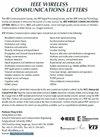无线环境信息能降低导频开销吗:一个信道预测的例子
IF 5.5
3区 计算机科学
Q1 COMPUTER SCIENCE, INFORMATION SYSTEMS
引用次数: 0
摘要
信道状态信息是海量多输入多输出(MIMO)系统的关键。随着天线规模的增加,获取CSI会导致系统开销的显著增加。在本文中,我们提出了一种新的信道预测方法,该方法利用无线环境信息和导频模式优化进行信道预测(WEI-CP)。具体而言,利用多视图图像获取对代表无线环境信息的CSI有显著影响的移动站周围散射体的分布。然后,为了挖掘无线环境信息(WEI)与CSI之间的映射关系,图像特征提取模块从多视图图像中提取环境特征图。此外,导频模式优化模块获取最优的固定导频模式来选择部分CSI。最后,利用环境特征映射和部分CSI,信道预测模块对完整CSI进行预测。仿真结果表明,该方法可将导频开销从1/5降低到1/8,提高预测精度,归一化均方误差降至0.0113,比未加WEI的信道预测方法提高83.2%。本文章由计算机程序翻译,如有差异,请以英文原文为准。
Can Wireless Environment Information Decrease Pilot Overhead: A Channel Prediction Example
Channel state information (CSI) is crucial for massive multi-input multi-output (MIMO) system. As the antenna scale increases, acquiring CSI results in significantly higher system overhead. In this letter, we propose a novel channel prediction method which utilizes wireless environment information with pilot pattern optimization for channel prediction (WEI-CP). Specifically, the distribution of scatterers around the mobile station (MS) significantly affecting the CSI, which represents the wireless environment information, is acquired using multi-view images. Then, to dig out the mapping relationship between wireless environment information (WEI) and CSI, the image feature extraction module extracts environment feature map from multi-view images. Additionally, the pilot pattern optimization module acquires an optimal fixed pilot pattern to select partial CSI. Finally, using the environment feature map and partial CSI, the channel prediction module predicts the complete CSI. Simulation results show that the WEI-CP can reduce pilot overhead from 1/5 to 1/8 and improve prediction accuracy, with the normalized mean squared error reduced to 0.0113, an 83.2% improvement over channel prediction method without WEI.
求助全文
通过发布文献求助,成功后即可免费获取论文全文。
去求助
来源期刊

IEEE Wireless Communications Letters
Engineering-Electrical and Electronic Engineering
CiteScore
12.30
自引率
6.30%
发文量
481
期刊介绍:
IEEE Wireless Communications Letters publishes short papers in a rapid publication cycle on advances in the state-of-the-art of wireless communications. Both theoretical contributions (including new techniques, concepts, and analyses) and practical contributions (including system experiments and prototypes, and new applications) are encouraged. This journal focuses on the physical layer and the link layer of wireless communication systems.
 求助内容:
求助内容: 应助结果提醒方式:
应助结果提醒方式:


